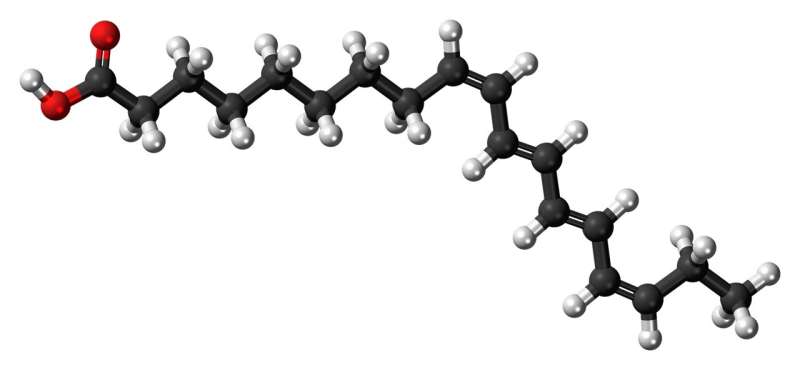
Spectacular images of a molecule that shuttles omega-3 fatty acids into the brain may open a doorway for delivering neurological therapeutics to the brain.
“We’ve managed to obtain a three-dimensional structure of the transporter protein that provides a gateway for omega-3s to enter the brain. In this structure, we can see how omega-3s bind to the transporter. This information may allow for the design of drugs that mimic omega-3s to hijack this system and get into the brain,” says first author Rosemary J. Cater, Ph.D., a Simons Society Fellow in the Mancia Lab at Columbia University Vagelos College of Physicians and Surgeons.
The study was published online on June 16 in the journal Nature.
A major challenge in treating neurological diseases is getting drugs across the blood-brain barrier—a layer of tightly packed cells that lines the brain’s blood vessels and zealously blocks toxins, pathogens, and some nutrients from entering the brain. Unfortunately, the layer also blocks many drugs that are otherwise promising candidates to treat neurological disorders.
Essential nutrients like omega-3s require the assistance of dedicated transporter proteins that specifically recognize them and get them across this barrier. “The transporters are like bouncers at a club, only letting molecules with invites or backstage passes in,” Cater says.
The transporter—or bouncer—that lets omega-3s in is called MFSD2A and is the focus of Cater’s research. “Understanding what MFSD2A looks like and how it pulls omega-3s across the blood-brain barrier may provide us with the information we need to design drugs that can trick this bouncer and gain entry passes.”
To visualize MFSD2A, Cater used a technique called single-particle cryo-electron microscopy.
“The beauty of this technique is that we’re able to see the shape of the transporter with details down to a fraction of a billionth of a meter,” says study co-leader Filippo Mancia, Ph.D., associate professor of physiology & cellular biophysics at Columbia University Vagelos College of Physicians and Surgeons and an expert in the structure and function of membrane proteins. “This information is critical for understanding how the transporter works at a molecular level.”
For cryo-EM analysis, protein molecules are suspended in a thin layer of ice under an electron microscope. Powerful cameras take millions of pictures of the proteins from countless angles which can then be pieced together to construct a 3D map.
Into this map researchers can build a 3D model of the protein, putting each atom in its place. “It reminds me of solving a jigsaw puzzle,” Mancia explains. This technique has become remarkably powerful in visualizing biological molecules in recent years, thanks in part to Joachim Frank, Ph.D., professor of biochemistry & molecular biophysics at Columbia University Vagelos College of Physicians and Surgeons, who won the Nobel Prize in 2017 for his role in developing cryo-electron microscopy data analysis algorithms.
“Our structure shows that MFSD2A has a bowl-like shape and that omega-3s bind to a specific side of this bowl,” Cater explains. “The bowl is upside down and faces the inside of the cell, but this is just a single 3D snapshot of the protein, which in real life has to move to transport the omega-3s. To understand exactly how it works, we need either multiple different snapshots, or better yet, a movie of the transporter in motion.”
To understand what these movements might look like, a second co-leader of the study, George Khelashvili, Ph.D., assistant professor of physiology and biophysics at Weill Cornell Medicine, used the 3D model of the protein as a starting point to run computational simulations that revealed how the transporter moves and adapts its shape to release omega-3s into the brain. A third co-leader of the study, David Silver, Ph.D., professor at the Duke-NUS Medical School in Singapore and pioneer in MFSD2A biology, together with his team tested and confirmed hypotheses derived from the structure and the computational simulations on how MFSD2A works to pinpoint specific parts of the protein that are important.
The team also included researchers from the New York Structural Biology Center, the University of Chicago, and the University of Arizona, all using their specific skills to make this project possible.
The team is now investigating how the transporter first recognizes omega-3s from the bloodstream. “But our study has already given us tremendous insight into how MFSD2A delivers omega-3s to the brain, and we are really excited to see where our results lead to,” Cater says.
Columbia University Irving Medical Center

